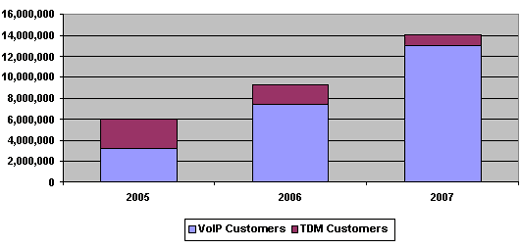
article
page | 1 | 2 | 3 |
cable modem services retain an advantage in high-speed lines. From approximately 63% of broadband services provided by telcos and cablecos in 2002, cable modem services still accounted for 56% of these services five years later. Cable-provided broadband simply "took off" faster than telcos' DSL services, in large part because cable companies had competitive incentive to do so.
|
|
|
In 2007, VoIP customers accounted for more than 90% of the cable industry's growing base of telephony subscribers. |
|

VoIP’s influence has been felt throughout the cable industry. For example, from 2006 to 2007 Charter more than doubled its voice
|
|
| Figure 2:
High-Speed Data Lines (over 200 kbps in at least one direction)
by Technology, 2000-2007 (millions of lines)

Source: NPRG, FCC |
|

|
VoIP as A Third Service--And A Cut Into the Telcos' Revenue Base
By year-end 2005, the number of cable VoIP subscribers exceeded cable TDM subscribers, and the gap will only continue to widen (see Figure 2). Cable companies are actively migrating customers to their next-gen IP networks, accelerating the trend. In 2007, VoIP customers accounted for more than 90% of the cable industry's growing base of telephony subscribers. | |

subscribers. Likewise, Time Warner Cable reported 57% voice revenue growth over the previous year—a figure the Company credited to strong customer demand.
Business Customer Segment: Working Progressively Upmarket
Historically, cable companies have focused on the residential segment—consumers of their core video services. More recently, the focus has shifted to include “business-class”
|
|
|
| Figure 3:
Cable Companies’ Voice Customers
VoIP vs. TDM, 2005-2007
(total subscribers)

Source: New Paradigm Resources Group
article
page | 1 | 2 | 3 | |
|





